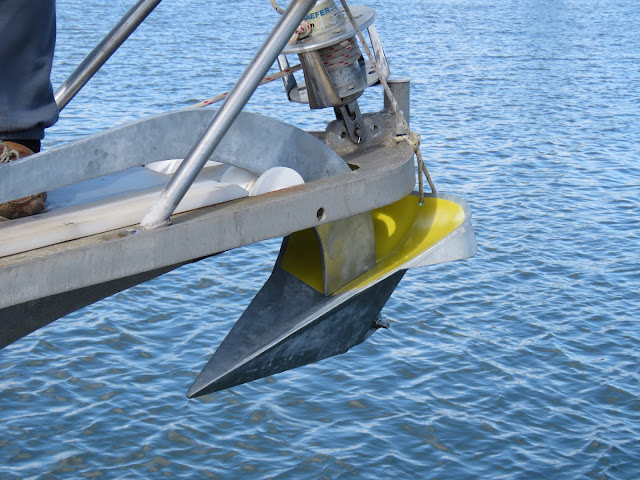Finally, on August 2, after twelve+ weeks of waiting, our last new window was installed on Gjoa. Eleven of the twelve windows we'd ordered had been installed the week before, but, for some reason, we had to wait another week for the very last one. It wasn't too bad living without windows for the last three months. However, in the last couple of weeks the 'winter' weather here in Whangarei, NZ had taken a turn for the worse and any exterior boat work had to be squeezed in between torrential downpours. Anyway, we got there in the end and we're very happy with the final result. They look great, the level of tinting is just fine and we can see out the windows for the first time! What a difference it has made. The windows are 14mm thick, consisting of an 8mm toughened, tinted glass exterior layer laminated with a 1mm laminate to a toughened, clear glass 5mm interior layer. Hopefully, this will stand up to the rigors that boat windows can be put through. If we have the misfortune to drop sideways off a wave and smash one, the theory is that the laminate will hold the shattered, toughened glass together and at least we won't have a giant hole in the boat. This should buy some time, enabling us to effect emergency coverage of the weakened pane. We hope we never have to test the theory. Due to the extended delivery time (it was supposed to be 6-8 weeks) that has delayed our departure, our only disappointment is in not having enough time to trim out the carpentry on the inside of the boat. So, that's another boat job that we'll carry with us for the next go-round of boat work.
On the same day the last window was installed, our solar panels finally showed up. They were also overdue, three weeks, they had to come on a ship from Australia. So, it was a mad scramble to get those installed so we could be on our way. The supports had already been welded on and luckily, everything fit with a few minor adjustments. We installed two, 24V/190W monocrystalline panels and a Victron MPPT controller. Wired in series these will produce up to 86.4 VOC and we expect them to fully carry our electrical load, even the power-hungry hydraulic autopilot pump, while the sun shines. It was very exciting to flick the switch and see those volts start to flow into the batteries. The solar panels that came with the boat had never worked.
As part of the solar install we were doing some electrical measuring and found that the 24V alternator attached to the Yanmar had a significant current leak. Another must-do job was added to the list. A local electrician was able to quickly source a new one that would fit without major adjustment. As a bonus, it was an 80 amp alternator, an upgrade from the 65 amp old one. We'd have liked to consider installing a 100 amp, large-case alternator, but, that would have meant significant rework and we didn't want to delay our departure any longer. The 80 amp version was installed within two days. At the same time, we installed a new leak detector so we can easily and quickly check for any future current leaks. It's a bargraph and will measure anything between 1-50 milliamps. Anything less than 8mA should be ok. Anything above that needs to be found and fixed immediately to avoid any corrosion to the boat.
We changed the colour of our bottom and did new primer and two topcoats.
We added a new anchor, a Spade S160 to replace a stainless CQR.
So, that was it, we'd gotten to the end of our must-do before departure list. On August 9, we left Riverside Drive Marina, our NZ home for the last 4-1/2 months and headed the fourteen miles back down the Hatea River towards the sea and Marsden Cove Marina where we needed to go to refuel and check out of the country. The weather hadn't been good for weeks and actually it wasn't great for the next few days either, but, it looked like it might improve enough in the next week to at least get us started on our way to French Polynesia, our next port of call.
----------
Sent via SailMail, http://www.sailmail.com






Safe journeys guys XOXOX 🥰♥️
ReplyDelete